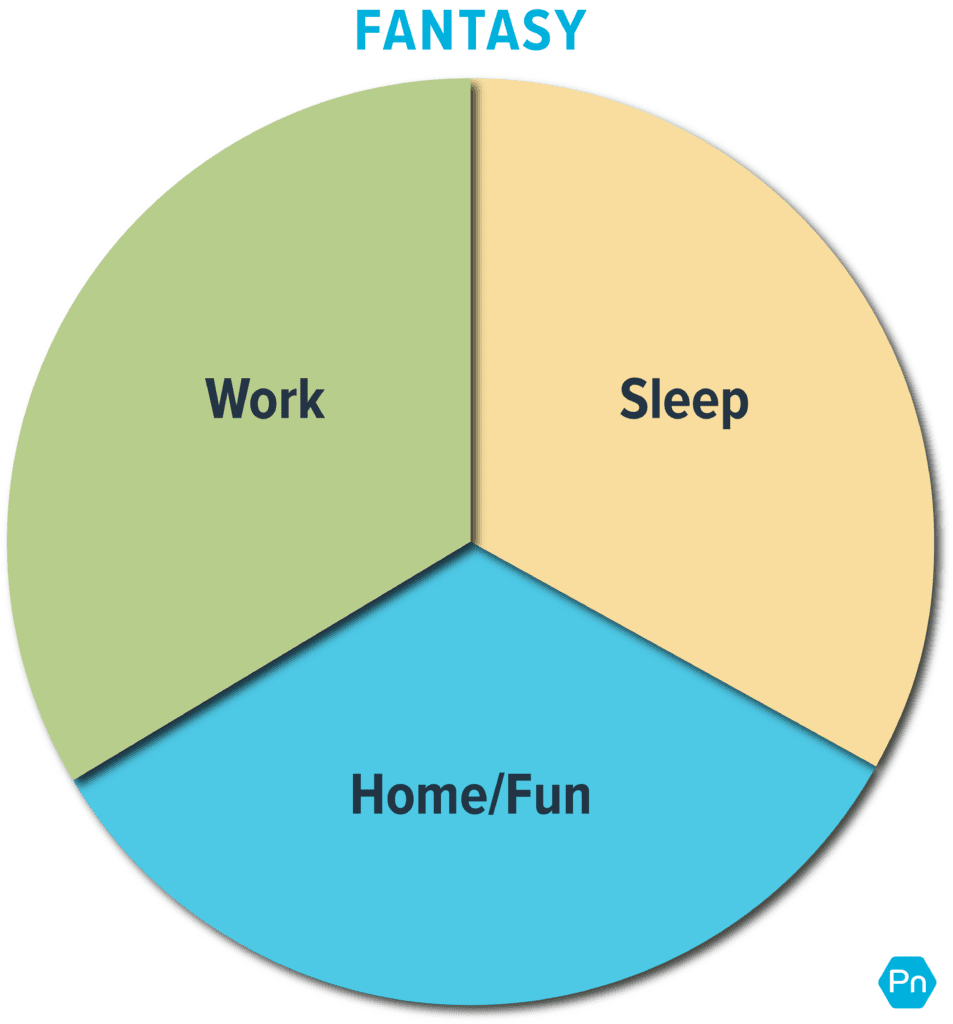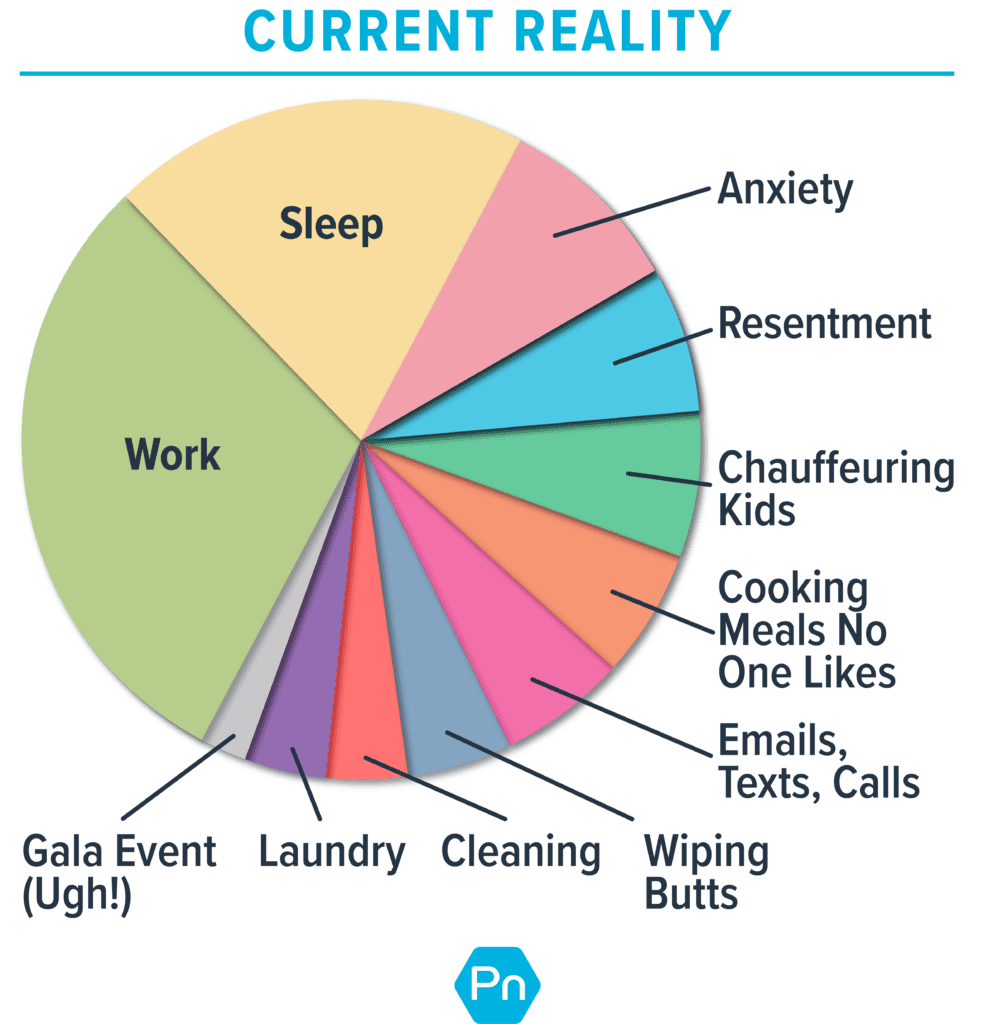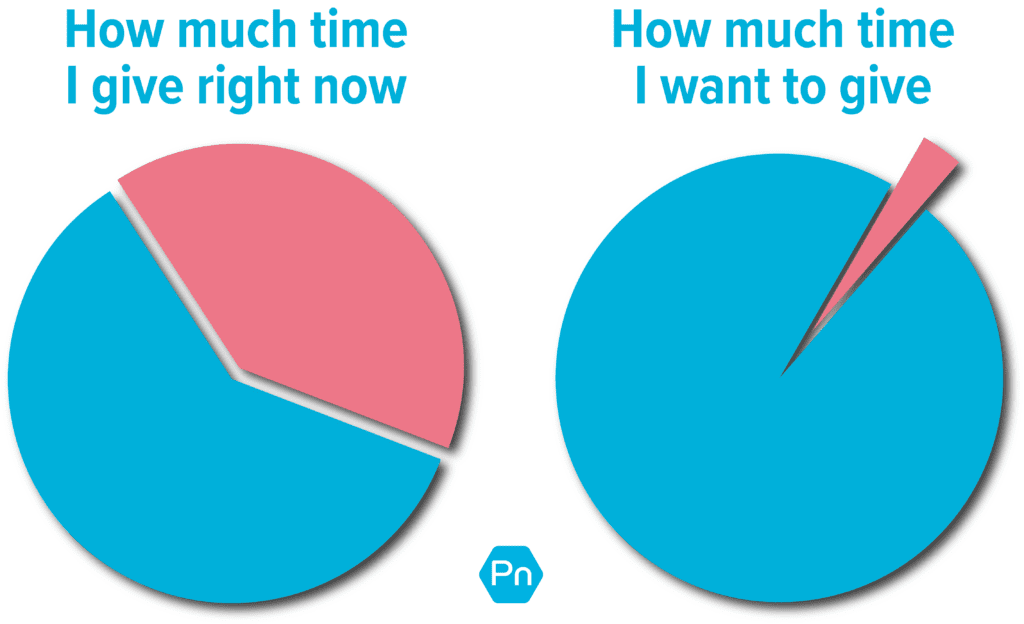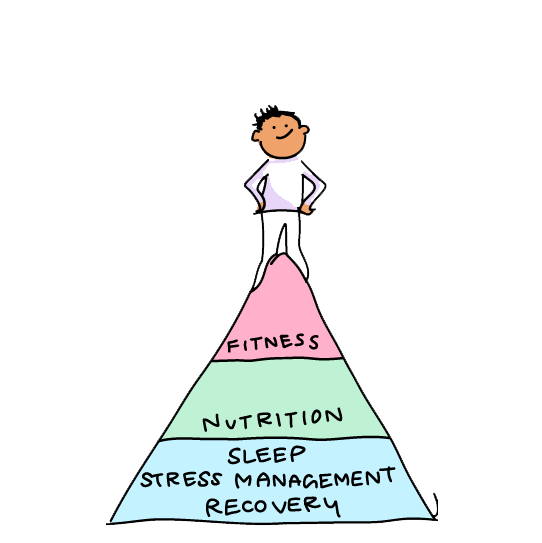Why is it so hard to say, “No”?
Well, for one, disappointing people feels horrible.
(You hate to be a flake.)
Maybe your star employee status depends on you saying, “Sure, I’ll stay late.”
Also, saying yes just feels easier, a lot of the time.
For example, when you say “yes, I’ll drive you to rugby,” it means a kid who gets to practice on time, and you returning to a peaceful house.
However:
Every time you say “yes” to one thing, you’re saying “no” to something else.
For example, when you say “yes” to:
- Watching the kids because you feel guilty asking your spouse to trade off, you also say “no” to that gym membership you paid for, but rarely use
- Your boss’s midnight requests, anxiously checking your work email until late, you also say “no” to a full, restful night’s sleep
- Everyone else’s demands (hi kids, aging parents, and the PTA), you also say “no” to those appointments with your dentist or massage therapist
The result: You feel like a ragdoll, pulled and tossed towards whoever needs you most. With no sense of your own priorities, or the respite to tend to them, you’re left feeling overwhelmed, overburdened, anxious, and stressed.
(Also: Hello, resentment.)
But try a thought experiment with us:
What if you flipped your responses—saying “yes” to yourself a little more often—and in turn, better tending to your own needs and goals?
And, what if you said “no” to more of the things that get in the way of that?
In the following article, we’ll offer three challenges to help you do that.
You’ll learn how to choose—with intention—when to say “yes” and when to say “no.”
One better: You’ll build the skills to turn down requests without feeling so guilty, insecure, or uncomfortable.
And don’t worry:
This isn’t a 90’s talk show-style confrontation with your loved ones. You don’t have to “complete makeover” your life. Or tell someone where to shove it.
Instead, you’ll inch along a continuum of “no,” at your own pace.
With practice, you’ll find a place for YOU on your to-do list, translating to better health, deeper recovery, and more energy.
You can’t control other people’s requests of you, but saying “no” is within your power. And it’s one of the most effective things you can do to manage stress.
Ready to try it? Let’s go.
Challenge #1: Track your time, energy, and attention
One reason you might agree to do too many things:
You may not actually know where your time, energy, and attention are going.
Without a clear sense of how much time you have in a day—and how you spend it—it’s easy to believe things like:
“Oh, of course I can train that new employee!”
OR:
“Most days, I don’t even have five minutes to myself.”
You might both over- and underestimate how much time you have in a day.
This challenge will help you see—on paper—where your time is going. With this information, you’ll be able to more consciously decide where you want your time to go.
To do it:
Pick a tracking method.
Download our Planning and Time Use Worksheet, use a time-tracking app, or create your own time-tracking system by using a notebook or calendar.
Record your daily activities.
Pay attention to what drains your energy and attention—as well as what boosts it. This information will come in handy in challenge #2.
Analyze your data.
After tracking for at least a day, look at your diary.
Any patterns or surprises? Is your time, energy, and attention going where you’d assumed? Are you spending more (or less) time on certain tasks than you thought? Finally, do you feel good about where your time, energy, and attention are going?
While you do this, be honest, but also kind to yourself. Chances are, this task will reveal some uncomfortable truths.
Here’s an example of a typical day that a client—a middle-class parent with a full-time job and three children under 10—shared with us.
| 6:30 AM-8:30 AM | Jump out of bed after hitting snooze, wrangle kids, prepare breakfast while checking work texts and emails from phone, get kids off to school and daycare |
| 8:30 AM-2:30 PM | Meetings and calls. Skip lunch, work straight through |
| 2:30 PM | On phone to insurance company while answering work emails |
| 3:30 PM | Pick up kids from school; scarf handfuls of their uneaten lunches while driving home to make 4 PM work meeting |
| 4 PM | Work meeting while making kids after-school snacks and putting in a load of laundry because youngest needs clean soccer uniform for practice at 6:30 PM |
| 5:30 PM | Rushed “dinner” (inhaling food while arguing with spouse about who has to drive) |
| 6:20 PM | Hop in car while yelling at kids to hurry up; speed to three different practices and lessons, one for each kid |
| 7:30 PM | Answer work emails and texts while on sidelines and sitting in car waiting for kids |
| 8:15 PM | Back home; discover one kid needs cupcakes for a class birthday tomorrow. Bake something from a mix while trying to bathe and put kids to bed, review homework, make lunches for tomorrow |
| 10:30 PM | Sit in bed exhausted, half-watching a true crime show with spouse, still answering work texts and emails |
| 12:30 AM | Lie awake worrying about tomorrow |
As you can see, she’s left zero space for… herself.
Not surprisingly, this client feels exhausted, overwhelmed, and anxious.
For many people, the above challenge is transformative.
It helps them see—sometimes with painful clarity—what their lived priorities are.
For example, the above client didn’t think of themselves as a “slave to work.” But her time diary revealed differently.
Challenge #2: Choose (intentionally) how to spend your time
Another reason you might say “yes” as a default response:
You don’t fully understand the tradeoffs.
In other words, when you say “yes,” you’re not aware of everything you’re saying “no” to at the same time.
This challenge helps you get real with those tradeoffs, and come up with a balance of “yeses” and “nos” that better reflects your goals.
To do it:
Create a chart that represents your current reality.
Take your data from challenge #1—and create a pie chart that shows how you spend your time, energy, and attention on a typical day.
Your pie chart represents 100 percent of your total capacity. Just like you can’t negotiate a 26-hour day, you can’t do more than 100 percent.
Your time is finite.
But as you start adding up components, you might notice that you’ve been trying to stuff 48 hours worth of stuff—or more—into one 24-hour cycle.
Or maybe you’ve been thinking your day is mostly devoted to productive activities that are aligned with your broader values and goals…
… But then you discover you spend at least an hour a day fighting with your wardrobe (why does nothing fit?!), and then another two hours scrolling through “aspirational” fitness accounts, making you feel even worse about your too-tight pants.
In other words, before doing this challenge, you might assume that your day looks like the fantasy below:

In reality, however, it might really look more like this…

No wonder you feel crummy. (Most shocking: Wiping your kids’ / dogs’ butts is the least of your woes!)
Decide if your pie slices are allocated to things you truly care about.
Consider each section of your chart, and ask yourself two questions:
- How much time, energy, and attention am I giving this right now?
- How much do I WANT to give? In other words, do you want that pie slice to be… bigger? Smaller? Or—poof!—gone? What are your hopes here?
It can help to think about these questions visually, as the below graphic shows.

Create your dream pie chart.
This represents how you want to spend your time, energy, and attention. Maybe your new reality looks something like the below.

Still wiping butts (hey, needs to be done).
But here, there’s a balance between output (you caring and providing for others) and input (you recovering, filling your own cup).
(And remember: Your time is still finite.)
Of course, the above is just an example.
Your pie chart will reflect your own priorities, goals, and values. (Your values are the things you consider most important, and often drive choices and behaviors.)
It might take you a few tries to get your pie chart the way you want it.
Play around with it. Experiment with making some slices a little bigger or smaller until you end up with something that’s a good fit—for you.
Most importantly, looking at your dream pie should inspire a feeling of “ahhhh.” A sigh of relief, but also a sense of excitement and energy.
Next, you’ll work towards how to make that “dream pie” more of a reality.
Challenge #3: Practice saying no
With your ideal pie chart in mind, you now have a visual that can help you decide what to say “no” to and what to say “yes” to.
But now, you’ll need to put it into practice.
And that means learning to actually say “no” to an actual person whose opinion matters to you.
Gulp.
But we’ve got your back, with a practice from Pam Ruhland, one of our in-house PN supercoaches, that’ll help you ease into saying “no” with more confidence.
To do it:
Imagine some “no” challenges.
Think about how you’ll turn down requests for your time, energy, and attention that sit outside of your “pie chart of priorities.”
Go through some hypothetical scenarios and come up with alternative responses to them. It can help to think of past obligations you took on that you ended up wishing you’d said no to.
How do you wish you would’ve responded?
Sometimes, you might want to keep your answer short, saying “No, I don’t have the bandwidth for that.” Or simply, “No.” (Yes, “No” is a full sentence!)
Other times you might want to combine a “no” with a “yes”—a compromise of sorts. For example:
▶ I can’t make that meeting [no to request]. Can we do it at X time instead? [yes to an alternative, or compromise]
▶ I can’t take on that project right now [no to request], but I know someone awesome who has a bit of time right now and would love the opportunity [yes, but for someone who wants to say yes].
▶ I can’t speak at that event if I have to travel [no to request], but if I can be a virtual speaker, I’d be happy to participate [yes, but only under certain conditions].
Consider situations in the past where it’s been hard for you to prioritize your needs, and think of where along the continuum of “no” you wish you’d responded with.
Try some mirror practice.
Look at yourself in the mirror and practice some versions of saying “no.”
Maybe, imagine that person you care about that’s really stretching you thin right now—and say “no” to them.
Allow yourself to feel that uncomfortable feeling that comes up for you when you turn someone down. Say “no” kindly and respectfully, but firmly.
For example:
- “I completely sympathize with your situation; I’m just not available.”
- “It’s really thoughtful of you to ask, but I can’t do it.”
- “Oh wow, that does look delicious. I’m full though.”
- “As I said, I’m not available after 6 PM.”
- “I’ve chosen not to drink right now. Please respect my choice.”
This exercise might feel silly (hello, you’re talking to you—in your housecoat no less) but it still might bring up some emotion.
You might feel guilty, self-indulgent, or hear the echoes of a parent who used to tell you it was impolite to turn down dessert, or lazy to turn down work.
Keep practicing in the mirror until the yucky feeling subsides (although it may never go away completely).
Acknowledge how difficult it can be to so clearly state your boundaries, and give yourself a pat on the back.
It’s showtime! Say “no” in real life.
Revisit your time diary and choose someone / something to say “no” to.
Know this: The first time will be the hardest. Start small, in situations you feel confident you can handle.
Sure, some people might not be happy with your response. After all, they liked having someone to bail them out—anytime, anywhere.
However, you’ll probably find that most people will accept your answer and still like you—and some of them will respect you more.
But the bigger payoff?
You take back some control over your life.
Instead of waiting for your kid, your boss, or a magic fairy to say to you, “You know what? You deserve some YOU time,” you take the reins.
You decide what’s important, and elbow that time out for yourself.
When you do, you give yourself a better chance at the kind of life you’ve always wanted—one with less stress, anxiety, and overwhelm, and more intention, energy, and joy.
That’s not only good for you, but for everyone.
If you’re a health and fitness pro…
When your clients are stressed and exhausted, everything else becomes a struggle: going to the gym, choosing healthy foods, and managing cravings.
But with the right tools, you can help your clients overcome obstacles like chronic stress and poor sleep—leading them toward the lasting health transformations they’ve always wanted.
PN’s Level 1 Sleep, Stress Management, and Recovery (SSR) Coaching Certification will give you these tools. And it’ll give you confidence and credibility as a specialized coach who can solve the biggest problems blocking any clients’ progress. (You can join the SSR Early Access List for our biggest discount + exclusive perks.)





Share